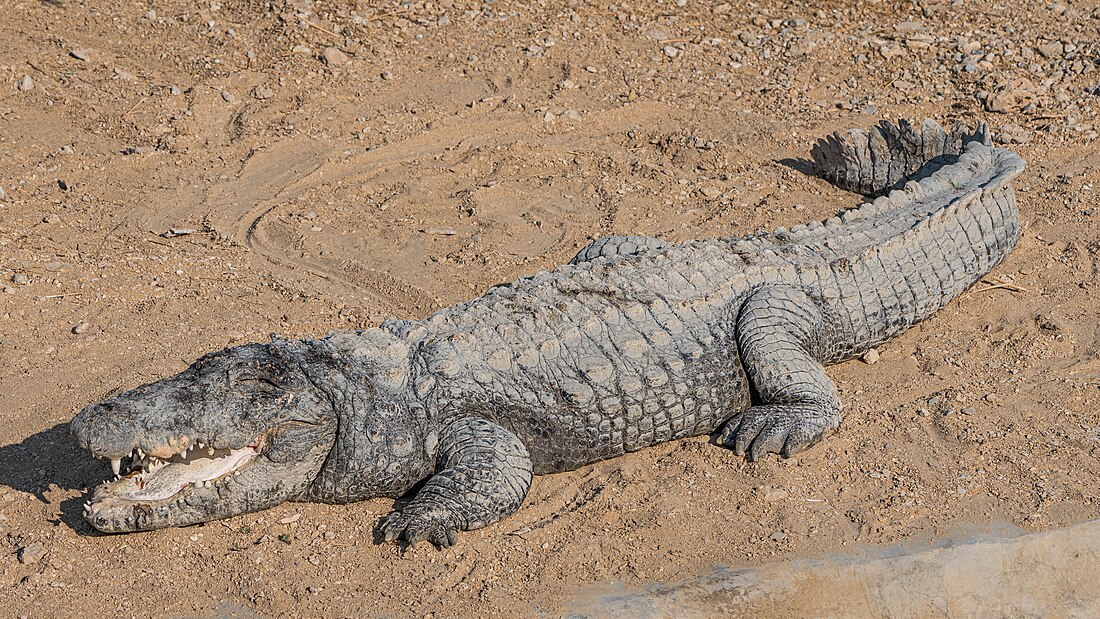Top Qs
Timeline
Chat
Perspective
Crocodylus
Genus of reptiles From Wikipedia, the free encyclopedia
Remove ads
Crocodylus is a genus of true crocodiles in the family Crocodylidae.
Remove ads
Taxonomy
Summarize
Perspective
The generic name, Crocodylus, was proposed by Josephus Nicolaus Laurenti in 1768.[2] Crocodylus contains 13–14 extant (living) species and 5 extinct species. There are additional extinct species attributed to the genus Crocodylus that studies have shown no longer belong, although they have not yet been reassigned to new genera.[3]
Extant species
The 13–14 living species are:
Fossils
Crocodylus also includes six extinct species:[3]
- † Crocodylus anthropophagus is an extinct crocodile from Plio-Pleistocene of Tanzania.
- † Crocodylus checchiai is an extinct crocodile from Late Miocene of Kenya.
- † Crocodylus falconensis is an extinct crocodile from Early Pliocene of Venezuela.
- † Crocodylus palaeindicus is an extinct crocodile the Miocene to the Pleistocene of southern Asia.
- † Crocodylus thorbjarnarsoni is an extinct crocodile from Plio-Pleistocene of Kenya.
- † Crocodylus sudani is an extinct crocodile from the Late Pleistocene of Sudan.
Remove ads
Evolution
Summarize
Perspective
While taxonomists generally agree that the crown group of Crocodylus appeared ~16 - 14 million years ago, there is an ongoing debate discussing whether the genus has an African or Indo-Pacific origin.[6][7] Proponents of the African origin point towards phylogenetic evidence suggesting that the most recent common ancestor of Crocodylus and its sister genus, Voay, diverged around 25 million years ago near the Oligocene/Miocene boundary.[6] This theory is supported by the existence of closely related African genera Osteolaemus and Mecistops.[6]
Proponents of the Indo-Pacific origin claim that the origin of the genus closely coincides with the appearance of the oldest known species, Crocodylus palaeindicus, in South Asia.[8] Additionally, mitochondrial analysis consistently places Indo-Pacific species Crocodylus mindorensis, Crocodylus novaeguineae, and Crocodylus johnstoni in the basal-most clade of the genus.[8][9] All known New World and African crocodylus species have a much more recent evolutionary origin.[8] While the exact origins of the genus remain uncertain, the most recent common ancestor of the species likely utilized osmoregulatory adaptations, including lingual salt glands, to radiate across the tropics.[7]
Phylogeny
A 2018 tip dating study by Lee & Yates simultaneously using morphological, molecular (DNA sequencing), and stratigraphic (fossil age) data established the inter-relationships within Crocodylidae.[10] In 2021, Hekkala et al. were able to use paleogenomics, extracting DNA from the extinct Voay, to better establish the relationships within Crocodylidae, including the subfamilies Crocodylinae and Osteolaeminae.[6] In 2023, Sales-Oliveira et al. suggested the relationships of recently recognised species (M. leptorhynchus, C. halli and the third Osteolaemus species).[11]
The below cladogram shows the results of the 2021 study, with supplementary data from the 2023 study:
| Crocodylidae |
| ||||||||||||||||||||||||||||||||||||||||||||||||||||||||||||||||||||||||||||||||||||||||||||||||||||||||||||||||||||||||||||||||||||||||||||||||||||||||||||||||||||||||||||||||||||||||||||||||||||||||||||
| (crown group) |
Remove ads
References
Wikiwand - on
Seamless Wikipedia browsing. On steroids.
Remove ads














